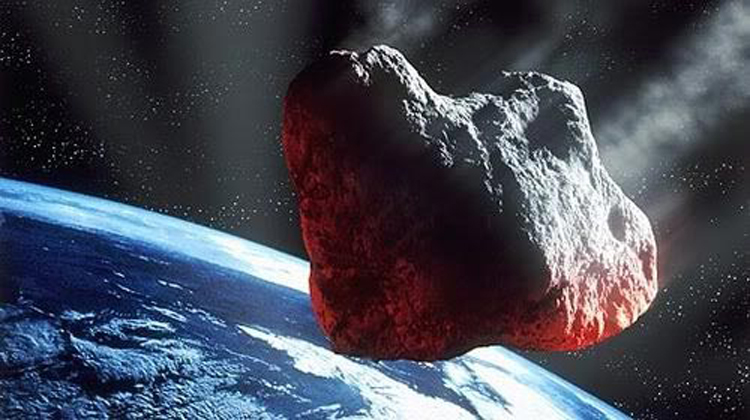Dangerous Space Rocks Discussed at Asteroid Day Prep

Experts from around the world gathered on Tuesday (Feb. 14) to discuss how humans can mitigate the threat of asteroid impacts, as well as to go over plans for future space probes and even for the mining of space rocks — all ahead of the third annual Asteroid Day, which arrives June 30.
The Asteroid Day press conference (which you can watch on YouTube) was broadcast from Luxembourg, with some participants joining from Bucharest, Romania; London; and Silicon Valley. It included Luxembourg Deputy Prime Minister Etienne Schneider and Britain's Astronomer Royal Sir Martin Rees.
"I think were all aware that we on spaceship Earth are vulnerable to impact from the outside," Rees said. "And for the first time, were in a position to remove this risk. … International organizations should realize it's an environmental issue." [Potentially Dangerous Asteroids in Pictures]
Part of the effort to develop technologies to mitigate the risk of an impact will come from missions to the smaller bodies of the solar system, said Patrick Michel, principal investigator of the Asteroid Impact Deflection and Assessment mission (AIDA).
AIDA will be the first mission to a binary asteroid, and it will for the first time show how a small probe can maneuver around a small body. The mission consists of the European Asteroid Impact Mission (AIM) and a NASA payload called Double Asteroid Redirection Test (DART). The NASA payload is an impactor fired at the asteroid to see how much that action affects the space rock's trajectory, testing one method of moving asteroids away from paths headed toward Earth.
Beyond the importance of the hazards posed by asteroids, though, there is the science that can be done at these objects, Michel said.
Get the Space.com Newsletter
Breaking space news, the latest updates on rocket launches, skywatching events and more!
"They are the best tracers of our solar system's history. They allow us to understand how planets form and how life emerged on Earth" he said. "They also correspond to the extreme conditions in terms of surface attraction, because they are so small, and we need to understand that to understand their evolution."
Knowing their histories will aid in using asteroids for purposes such as mining, Michel added.
Mining in space may become reality, said Etienne Schneider, Luxembourg's deputy prime minister and minister of the economy. Asteroid Day shows how Luxembourg can take a leading role, he added.
The country is home to SES, one of the largest satellite operators in the world, with more than 60 communications satellites. Schneider noted that the country has a lot o expertise in the space industry as a result.
"Asteroids are often seen as a threat but they are also an opportunity," Schneider said. "The use of space resources holds a large potential for future technological innovation. … To ensure this vision becomes reality, [we] must increase understanding of asteroids and near-Earth objects."
He added that he was disappointed that the European Space Agency (ESA) did not approve an additional asteroid mission when the agency's member nations met to decide on future directions for exploration late last year.
Franco Ongaro, director of technology, engineering and quality at ESA, also expressed disappointment that the AIDA mission was not fully funded. Originally, it was budgeted at about 250 million euros ($264 million).
"We are working with industry to meet deadline and reduce cost to make it more affordable," he said.
The AIDA mission is funded from a different pool of funds than the science missions, Michel told Space.com. It is still scheduled for launch in 2020, but will need to cost less than 200 million euros ($211 million). "It will still fly," he said.
Former NASA astronaut Ed Lu, CEO of the B612 Foundation, which is dedicated to protecting Earth from asteroid strikes, said the outreach for Asteroid Day and missions like AIM are also about showing what people can do if they work together.
"I find it amazing that we are now at the point where we talk about changing the solar system, changing the actual structure and evolution of system for human good," he said. "I think this is what this is all really about."
Follow us @Spacedotcom, Facebook or Google+. Published on Space.com.
Join our Space Forums to keep talking space on the latest missions, night sky and more! And if you have a news tip, correction or comment, let us know at: community@space.com.

Jesse Emspak is a freelance journalist who has contributed to several publications, including Space.com, Scientific American, New Scientist, Smithsonian.com and Undark. He focuses on physics and cool technologies but has been known to write about the odder stories of human health and science as it relates to culture. Jesse has a Master of Arts from the University of California, Berkeley School of Journalism, and a Bachelor of Arts from the University of Rochester. Jesse spent years covering finance and cut his teeth at local newspapers, working local politics and police beats. Jesse likes to stay active and holds a fourth degree black belt in Karate, which just means he now knows how much he has to learn and the importance of good teaching.









